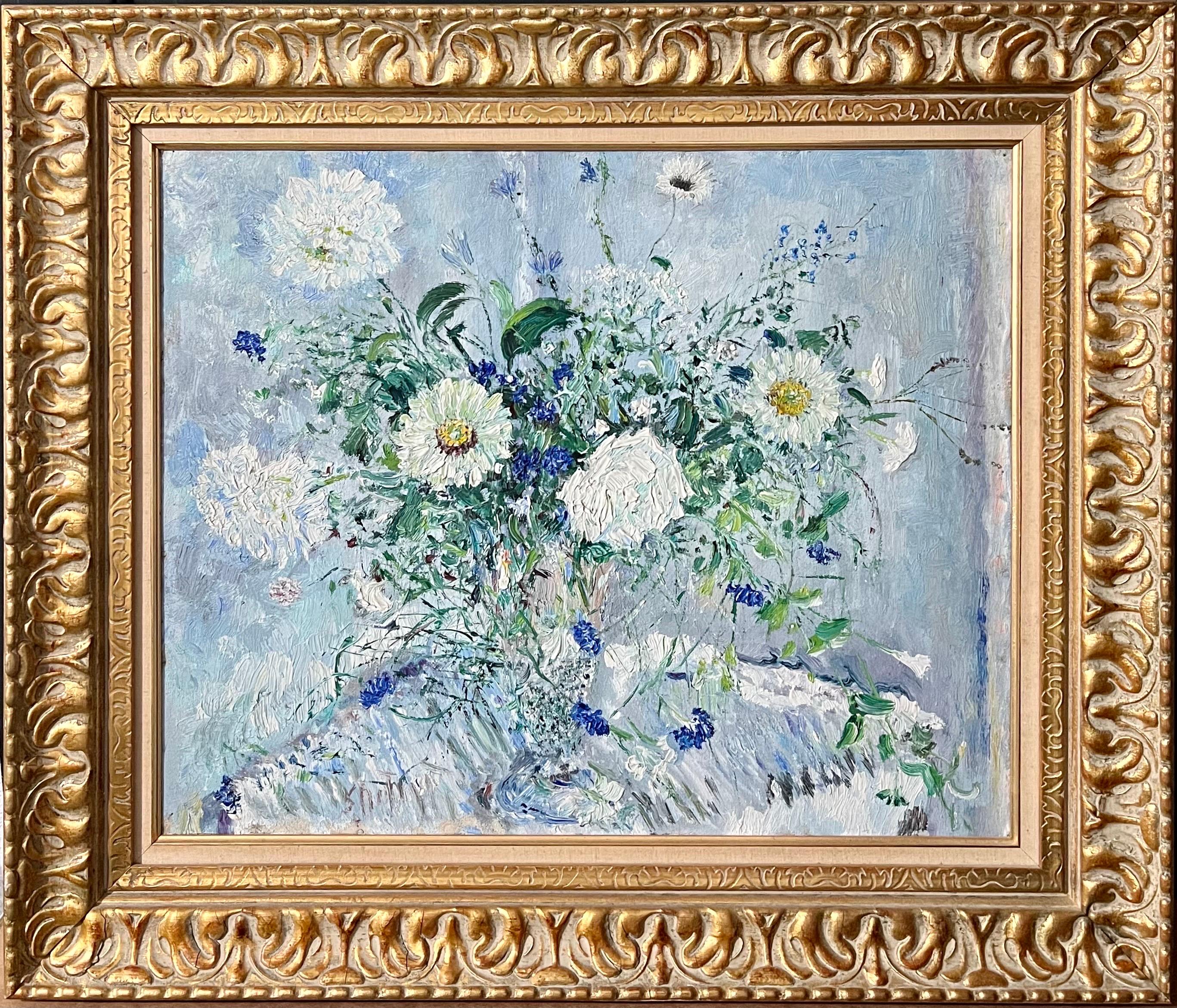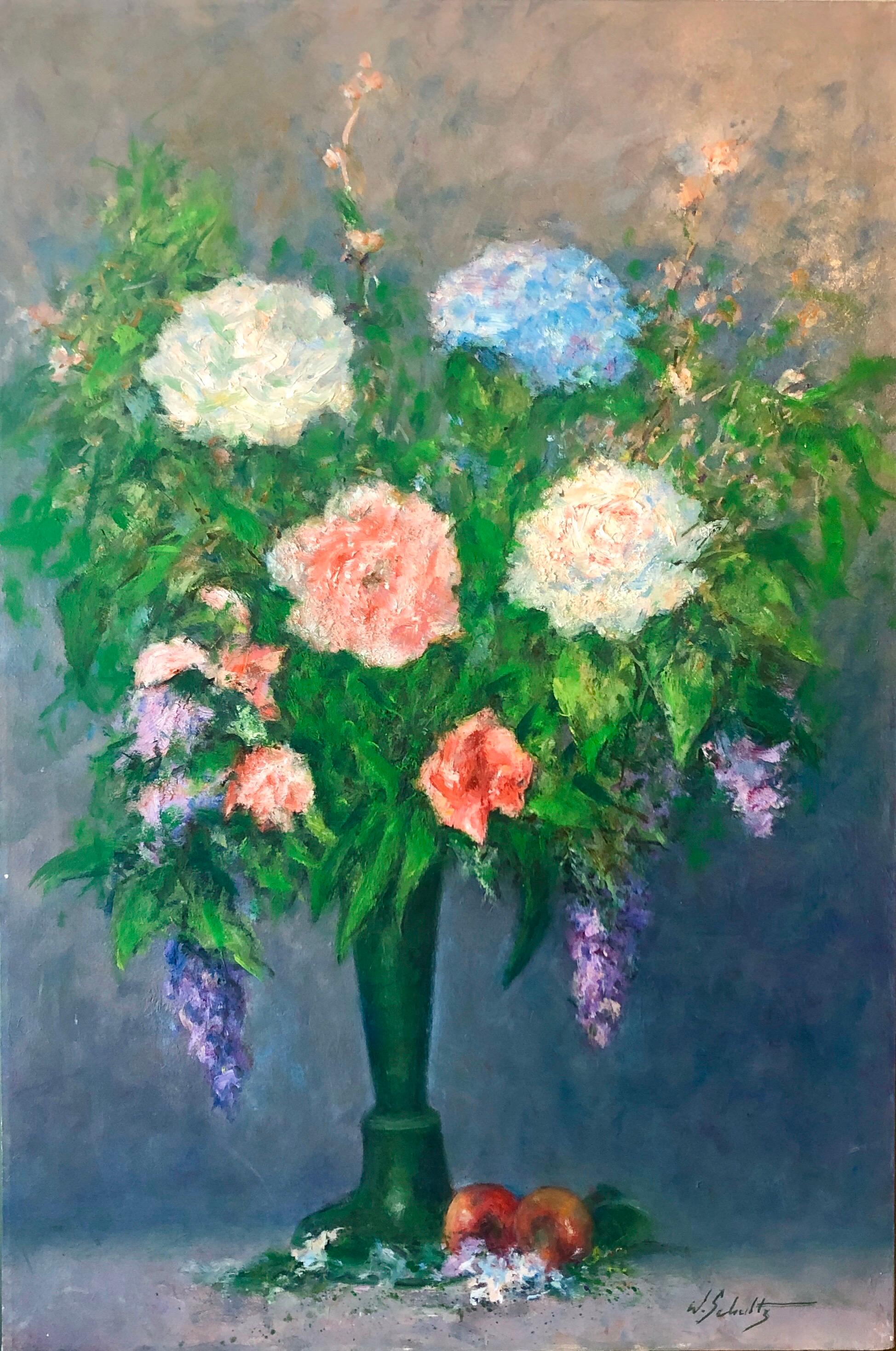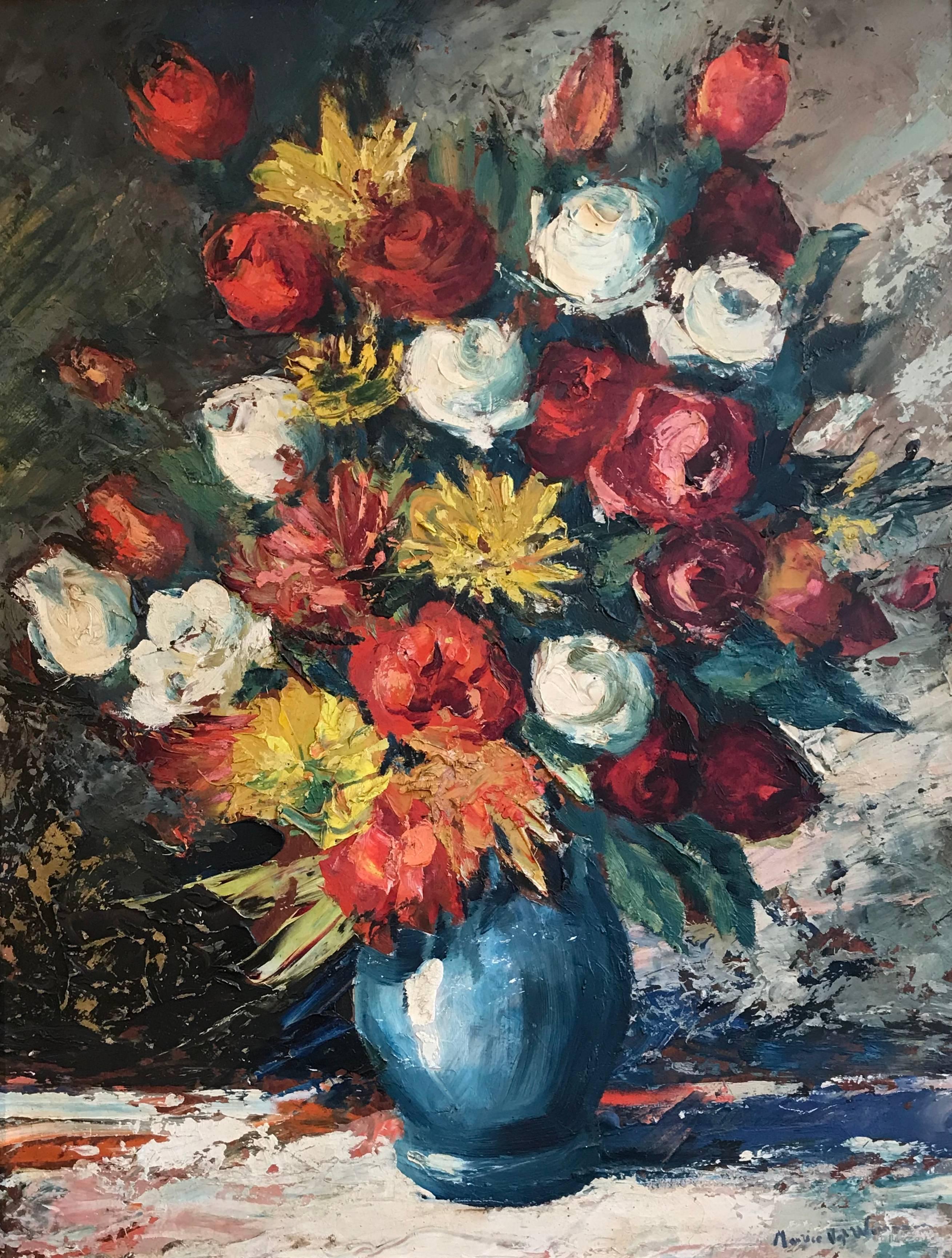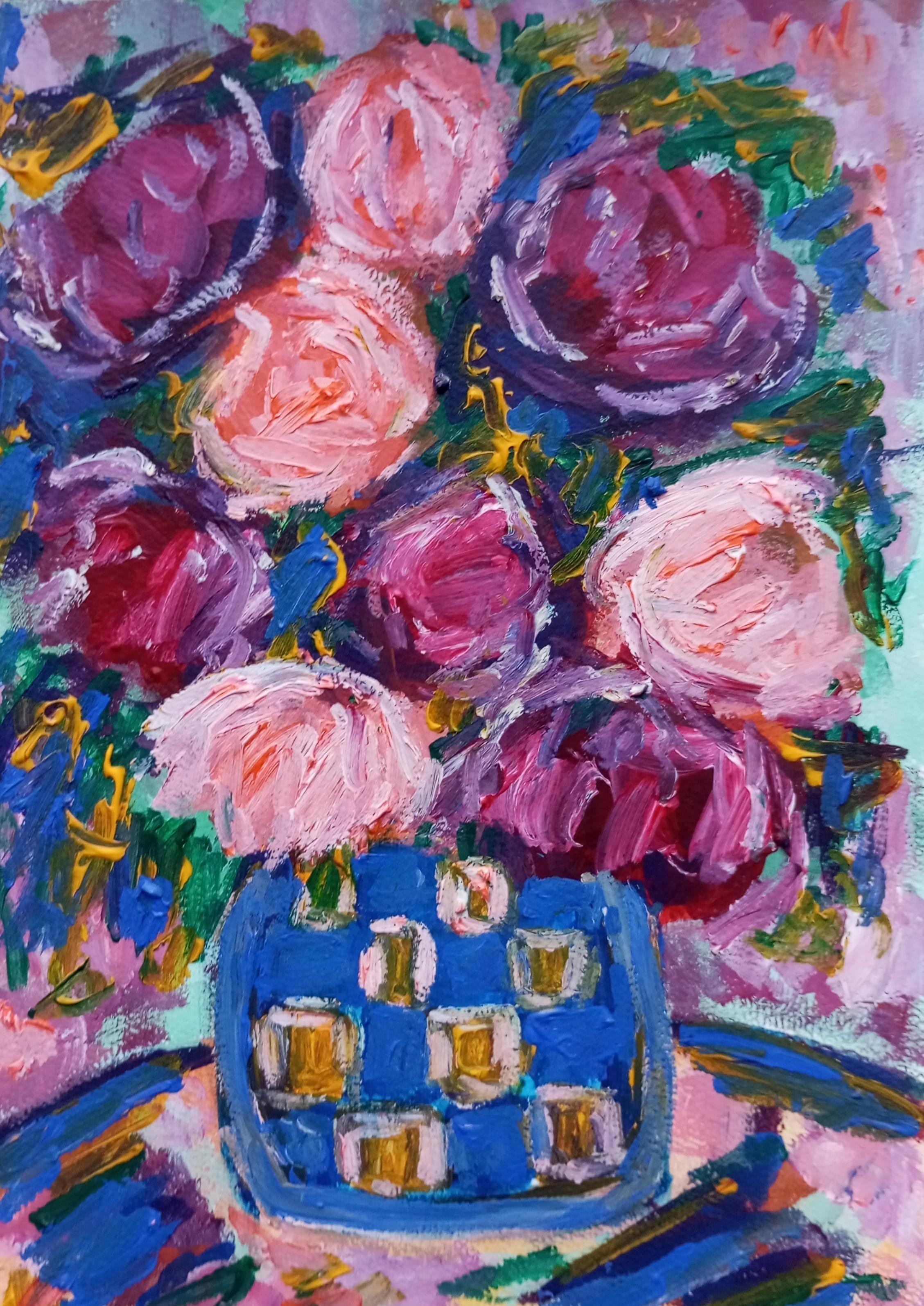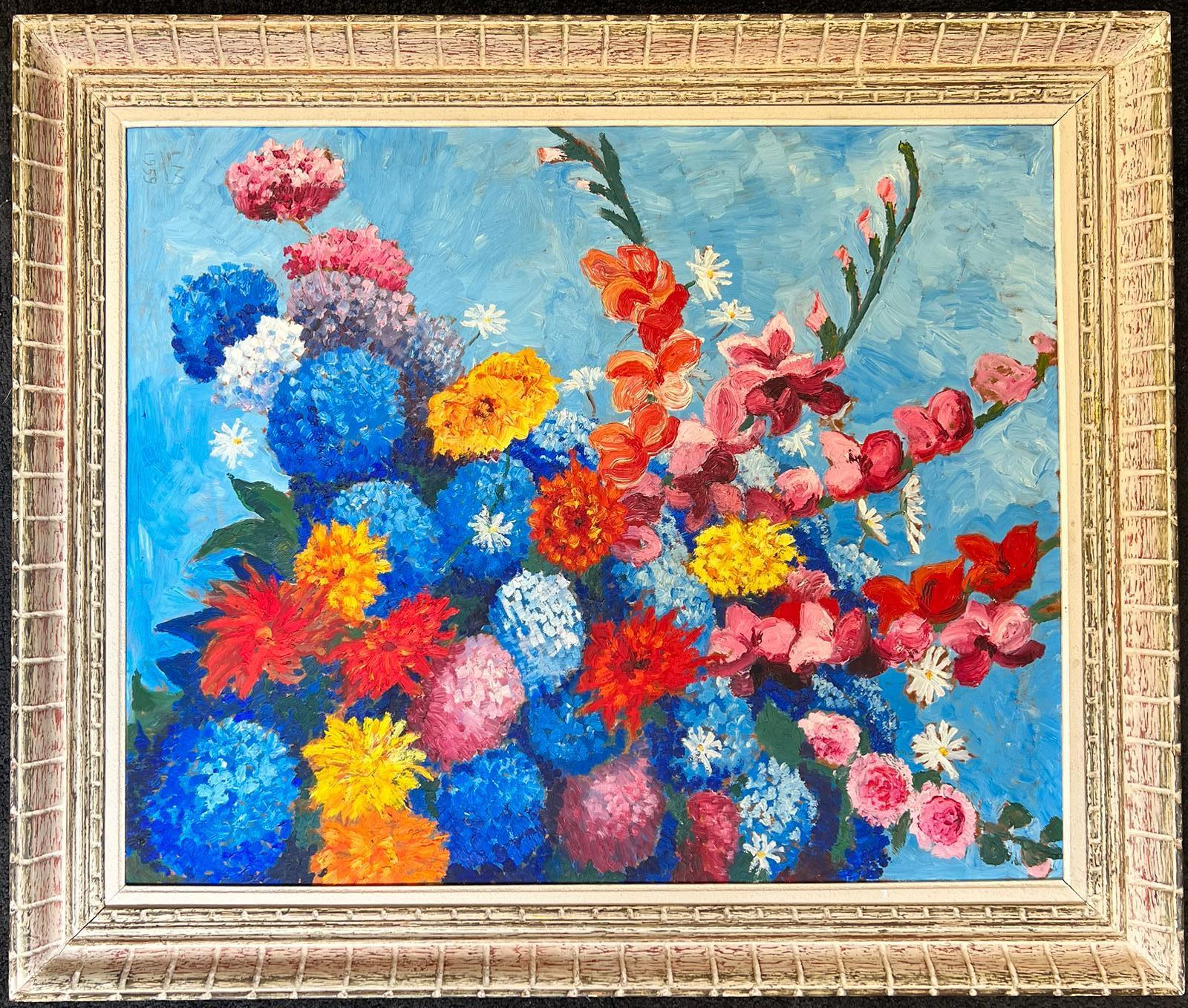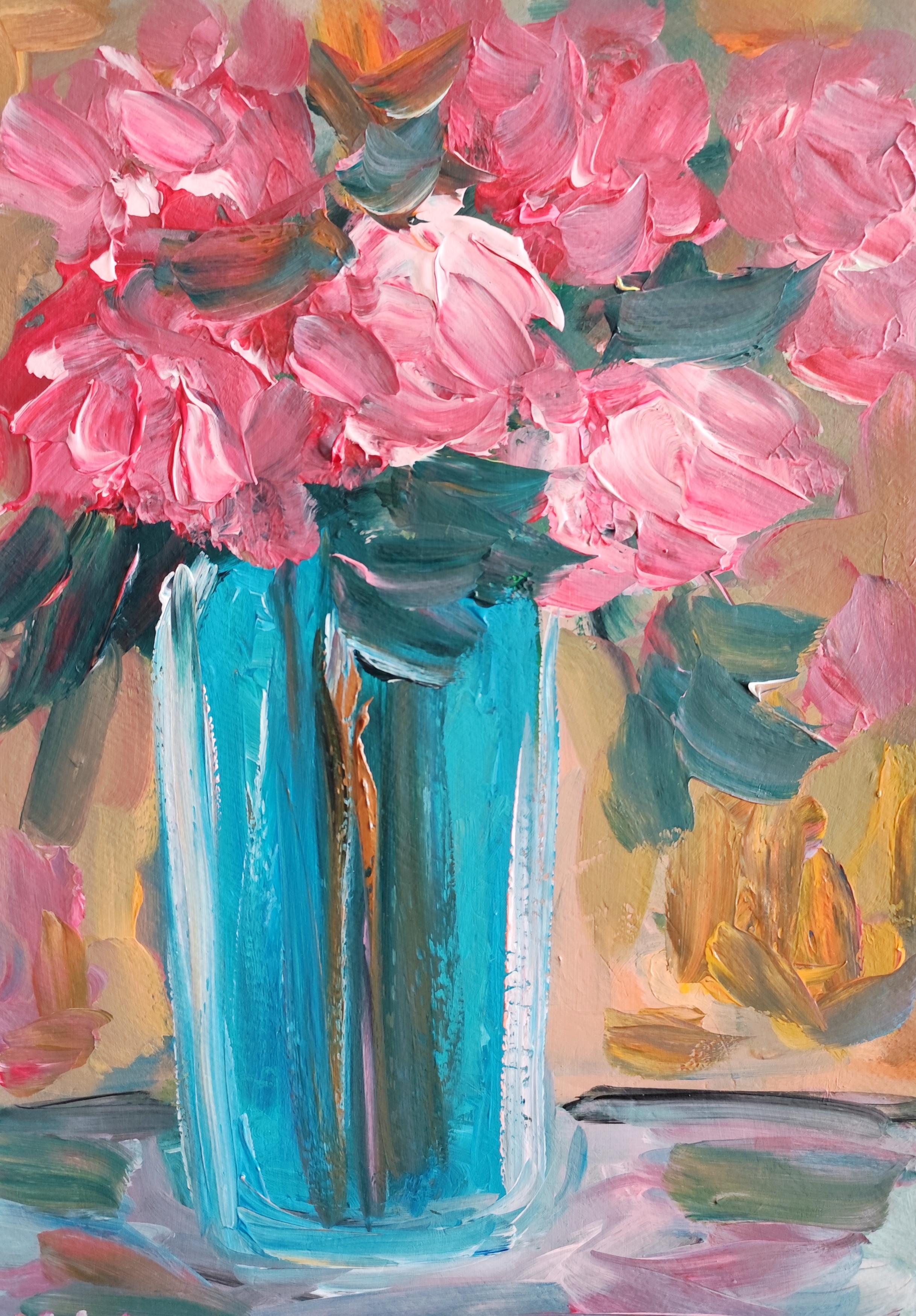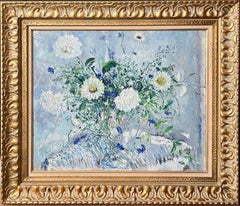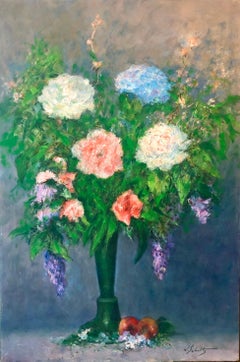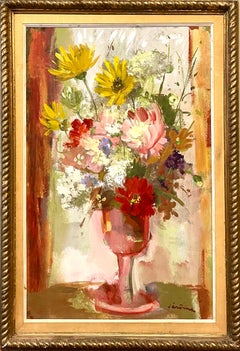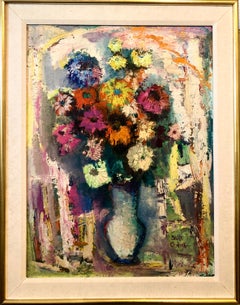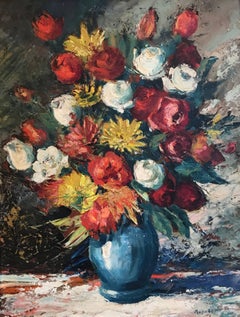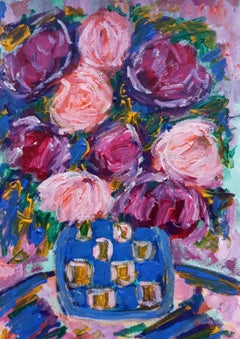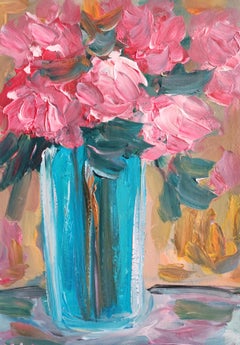Items Similar to Large Bold Modernist Floral Bouquet Impasto Oil Painting Flowers Samuel Rothbort
Want more images or videos?
Request additional images or videos from the seller
1 of 12
Samuel RothbortLarge Bold Modernist Floral Bouquet Impasto Oil Painting Flowers Samuel Rothbortc.1940's-1950's
c.1940's-1950's
$4,000
£3,035.11
€3,470.37
CA$5,586.92
A$6,211.89
CHF 3,243.51
MX$75,613.82
NOK 41,385.72
SEK 38,776.45
DKK 25,900.04
Shipping
Retrieving quote...The 1stDibs Promise:
Authenticity Guarantee,
Money-Back Guarantee,
24-Hour Cancellation
About the Item
Samuel Rothbort (1881-1972)
Floral, oil on canvas mounted board
22 x 30 1/2 in (55.9 x 77.5 cm),
Hand signed lower right.
Provenance: From the estate of the artist by descent to the granddaughter.
Samuel Rothbort (Russian American Jewish folk artist 1881-1972) was born in the small town, shtetl of Wolkovisk in the Russian Woodlands.During his youth he worked as a cantor and traveled to various towns and villages, gaining many impressions of life in that era. Poverty as well as the political unrest of the times led to his immigration to America in 1904. Upon arrival in America, Samuel Rothbort worked as a laborer and muralist eventually giving that up to become a watchman of newly built homes. While on duty he began molding figures in clay and upon the advice and encouragement of his employer and colleagues he began to take his artistic talents more seriously and pursued this endeavor. Rothbort therefore began doing free-hand painting, murals on walls and ceilings for private homes and commercial establishments. In 1909 he met and married Rose Kravitz, which marked the start of his career as an artist. Well known for his scenes of New York City life, executed in heavy impasto. Rothbort exhibited from the 1920s-60s, at the Salons of America, Pratt Institute, Brooklyn Museum, and a gallery at Rockefeller Center; however, he refused to sell his work, and in 1948, opened the Rothbort Home Museum of Direct Art, in his studio-home.
Samuel Rothbort was a self taught outsider artist painting every subject in his own folk art impressionistic style. His artistic range was broad and he never stopped creating. He was fascinated with nature and his works are filled with his delightful perceptions of his surroundings. Rothbort worked in oil, watercolor, and pen & ink. In the years of the depression there was little money, Rothbort could not afford paint or canvas. It was there that he began carving wood and stone using found materials like driftwood, rails, and old fence posts. While not associated with the WPA, he was an artist of that period and sensibility. Rothbort entered the art world and spent much of his life in pursuit of modernist painting and sculpture. He was a member the Society of Independent artists, the Salons of America, the People's Art Guild, and the Brooklyn Society of Artists. During the 1920's and early 1930's , Samuel Rothbort was regularly represented in exhibitions organized by The Brooklyn Museum of Art. Through the 1930's , Rothbort exhibited his watercolors and sculptures at Grant Studios in Brooklyn. In 1940, he began a 28 year relationship with the Barzansky Gallery on Madison Avenue in New York City exhibiting oils, watercolors, and sculpture in individual and group shows.
From 1915 through the 1960's, he was represented by many commercial galleries. Hamilton Easter Field, artist, publisher and founder of the Brooklyn Society of Artists was an early supporter of Rothbort's art work and helped further his career.
Rothbort received much recognition for his naive folk art paintings which he often displayed in unique primitive frames that he had hand-carved he is also known for his social realist street scene paintings. In 1952, Rothbort wrote a book on his sculpture, entitled "Out of Wood and Stone", which he dedicated to Hamilton Easter Field. A significant expression for Samuel Rothbort's career occurred in the late 1930's through the 1940's when he began painting "memory paintings " or recreation of his boyhood experiences of life in the ghettos and surrounding areas of the woodlands and marshes of Polesia - White Russia. A prized winning documentary, "Memories of The Shtetl" was produced by Harriet Semegram (previously titled " The Ghetto Pillow ") and shown at the Edinburgh Film Festival. It utilized 215 of Samuel Rothbort's watercolors and became the major visual resource material for Jerome Robbins movie and play, " Fiddler On The Roof ". Another award winning documentary on Jewish Folk Art " The Lost Wooden Synagogues of Eastern Europe " which was produced by Albert Barry and Florida Atlantic University, used many of Rothbort's paintings in the film to show life in pre-war Eastern Europe. The film was shown at the U.S. Holocaust Museum in Washington, D.C. and on Public Television.
He was a member of The Brooklyn Soc. of Artists; Soc. of Indp. Artists; and Brooklyn WCC. He exhibited at the SIA, 1917-40; Pratt Inst., 1919-22; Salons of Am., 1922-34; Brooklyn Mus., 1922-33; Charles Barzansky Gal., NY, 1940-44; Jewish Mus., NYC, 1984-85. His works hang in the NMAA; Brooklyn Mus.; Heckscher Mus.; Mus. of Stony Brook; Montclair AM; Sardoni AG; and Rutgers Univ. AG. Samuel was best known for his scenes painted in and around NYC. He had a bold style marked by heavy impasto.
Selected Solo Exhibitions:
2003 New York, NY; Luise Ross Gallery
New York, NY; Hollis Taggart Galleries
1998 East Hampton, NY; Morgan Rank Gallery
New York, NY; Benjamin Cardozo Gallery, Yeshiva University Museum
1997 New York, NY; Giampietro Gallery
1985 Brooklyn, NY; Chassidic Art Institute
1968, 64 New York, NY; Kaufman Art Center
1940-6, 54, 56, 61, 65 New York, NY; Charles Barzansky Galleries
1960 Chicago, IL; Welna Gallery
1940 Brooklyn, NY; Tilden Gallery
1938 Brooklyn, NY; Lincoln Gallery
1934 Brooklyn, NY; Grant Studios
Selected Group Exhibitions:
1998 Huntington, NY; Heckscher Museum, Celebrating New York:
A Centennial Exhibition
1984-86 New York, NY; The Jewish Museum, The Jewish Heritage in
American Folk Art (Travelling exhibition)
1968 New York, NY; National Arts and Antiques Show
1940-68 New York, NY; Charles Barzansky Galleries
1964 Bethesda, MD; Chevy Chase Gallery
1963 Huntington, NY; Heckscher Museum
1944 Richmond, VA; Virginia Museum of Fine Arts
1917-23, 25-31, 34, 38-40 New York, NY; Society of Independent Artists
1939 New York, NY; Academy of Allied Arts Gallery
1937-39 New York, NY; Vendome Gallery
1934, 39 New York, NY; Fifteen Gallery
1936-37 New York, NY; Municipal Art Commission
1932-36 Brooklyn, NY; Grant Studios
1923, 24, 25, 26, 36 Brooklyn, NY; Plymouth Institute, Beecher Gallery
1922, 23, 25, 27, 31, 34, 35 Brooklyn, NY; Brooklyn Museum of Art
1922, 23, 24, 25, 30, 34 Brooklyn, NY; Salons of America
1934 New York, NY; The Forum
1932, 33, 34 Hempstead, NY; Art League of Nassau County
1932 Brooklyn, NY; Painter and Sculptors Gallery
1924, 25, 30 New York, NY; Anderson Galleries
1922, 23 New York, NY; Galleries of American Art Association
1919 Brooklyn, NY; Pratt Institute, Art Gallery
Brooklyn, NY; Ardsley Studios
1917-19 Brooklyn, NY; Pouch Gallery
1915, 17 New York, NY; Peoples Art Guild
Samuel Rothbort's work is in many public and private collections, which include the Smithsonian American Art Museum in Washington, D.C.
- Creator:Samuel Rothbort (1882-1971, American)
- Creation Year:c.1940's-1950's
- Dimensions:Height: 22 in (55.88 cm)Width: 30.5 in (77.47 cm)
- Medium:
- Movement & Style:
- Period:
- Condition:Good. minor wear commensurate with age and technique.
- Gallery Location:Surfside, FL
- Reference Number:1stDibs: LU38214529912
About the Seller
4.9
Platinum Seller
Premium sellers with a 4.7+ rating and 24-hour response times
Established in 1995
1stDibs seller since 2014
1,784 sales on 1stDibs
Typical response time: <1 hour
- ShippingRetrieving quote...Shipping from: Surfside, FL
- Return Policy
Authenticity Guarantee
In the unlikely event there’s an issue with an item’s authenticity, contact us within 1 year for a full refund. DetailsMoney-Back Guarantee
If your item is not as described, is damaged in transit, or does not arrive, contact us within 7 days for a full refund. Details24-Hour Cancellation
You have a 24-hour grace period in which to reconsider your purchase, with no questions asked.Vetted Professional Sellers
Our world-class sellers must adhere to strict standards for service and quality, maintaining the integrity of our listings.Price-Match Guarantee
If you find that a seller listed the same item for a lower price elsewhere, we’ll match it.Trusted Global Delivery
Our best-in-class carrier network provides specialized shipping options worldwide, including custom delivery.More From This Seller
View AllBold Folk Art Modernist Floral Bouquet Oil Painting Flowers in Vase Gilt Frame
By Samuel Rothbort
Located in Surfside, FL
SAMUEL ROTHBORT (Russian-American, 1882-1971), still life with wild flowers, oil on canvas board, signed lower left.
Framed 25.5 X 30, board 18.5 X 23
Samuel Rothbort (Russian American Jewish folk artist 1881-1972) was born in the small town, shtetl of Wolkovisk in the Russian Woodlands.During his youth he worked as a cantor and traveled to various towns and villages, gaining many impressions of life in that era. Poverty as well as the political unrest of the times led to his immigration to America in 1904. Upon arrival in America, Samuel Rothbort worked as a laborer and muralist eventually giving that up to become a watchman of newly built homes. While on duty he began molding figures in clay and upon the advice and encouragement of his employer and colleagues he began to take his artistic talents more seriously and pursued this endeavor. Rothbort therefore began doing free-hand painting, murals on walls and ceilings for private homes and commercial establishments. In 1909 he met and married Rose Kravitz, which marked the start of his career as an artist. Well known for his scenes of New York City life, executed in heavy impasto. Rothbort exhibited from the 1920s-60s, at the Salons of America, Pratt Institute, Brooklyn Museum, and a gallery at Rockefeller Center; however, he refused to sell his work, and in 1948, opened the Rothbort Home Museum of Direct Art, in his studio-home.
Samuel Rothbort was a self taught, naive, outsider artist painting every subject in his own folk art impressionistic style. His artistic range was broad and he never stopped creating. He was fascinated with nature and his works are filled with his delightful perceptions of his surroundings. Rothbort worked in oil, watercolor, and pen & ink. In the years of the depression there was little money, Rothbort could not afford paint or canvas. It was there that he began carving wood and stone using found materials like driftwood, rails, and old fence posts.
Rothbort entered the art world and spent much of his life in pursuit of modernist painting and sculpture. He was a member the Society of Independent artists, the Salons of America, the People's Art Guild, and the Brooklyn Society of Artists. During the 1920's and early 1930's , Samuel Rothbort was regularly represented in exhibitions organized by The Brooklyn Museum of Art. Through the 1930's , Rothbort exhibited his watercolors and sculptures at Grant Studios in Brooklyn. In 1940, he began a 28 year relationship with the Barzansky Gallery on Madison Avenue in New York City exhibiting oils, watercolors, and sculpture in individual and group shows.
From 1915 through the 1960's, he was represented by many commercial galleries. Hamilton Easter Field, artist, publisher and founder of the Brooklyn Society of Artists was an early supporter of Rothbort's artwork and helped further his career.
Rothbort received much recognition for his naive folk art paintings...
Category
20th Century Post-Impressionist Interior Paintings
Materials
Oil
American Impressionist Floral Oil Painting Vibrant Flowers in Vase
By William Schultz
Located in Surfside, FL
William J. Schultz, American (1919 - 2005)
William J. "Bill" Schultz had been a renowned American Impressionist artist and teacher for over sixty-five years.
Co-Founder, and Director of the AIS had inspired numerous professional artists and teachers through his teaching. He also was a Master Pastelist in the Pastel Society of America and had won many awards for his oil and pastel paintings.
Born in Pittsfield, Massachusetts in 1919, he died in Vero Beach, Florida in 2005. He served in the Army in World War II including duty in Europe. He was discharged in 1946 with rank of First Sergeant. Schultz began his art studies with Martin C. Hoy, a fine artist and student of Robert Henri and William M. Chase. He graduated from The Vesper George School Of Art in Boston, Massachusetts in 1949. He then studied under National Academicians Jerry Farnsworth, Ivan Olinsky (a student of John Singer Sargent) and Robert Brackman. Winner of many awards for oil and pastel works. Was a noted portrait artist.
He was a founding Director of the American Impressionist Society and an award winning member of the Pastel Society Of America. He studied under notable National Academicians Robert Brachman, Ivan Olinsky and Jerry Farnsworth.
Schultz opened his own art studio and school in Lenox, Massachusetts and taught impressionist painting to hundreds of students, some of whom are now nationally recognized themselves. After 25 years at that location Schultz and his wife moved to Vero Beach, Florida where he continued to teach, as well as provide lectures and exhibitions around the country.
Illustrated articles about Schultz and his work have appeared in "American Artist", "Southwest Profiles", "Artists Of Florida" and other periodicals.
For a short time he studied alongside Norman Rockwell at a studio in Stockbridge, Massachusetts where Rockwell had established the base for his illustration work. Schultz was the proud possessor of an autographed sketch of himself that Norman Rockwell had created and was signed by Rockwell.
Schultz's art has been exhibited in museums and galleries in Boston, New York City, Sante Fe, and numerous Florida locations...
Category
20th Century American Impressionist Interior Paintings
Materials
Canvas, Oil
Vibrant Floral Oil Painting Vase of Spring Flowers Pierre Jerome Ecole De Paris
By Pierre Jerome
Located in Surfside, FL
Framed 23 x 15.75
Image 21.5 x 14.25
Pierre Jerome French 1905-1982
During his 50+ year career as an artist, he won several major awards, including awards at the Prix de Rome, in...
Category
20th Century Post-Impressionist Still-life Paintings
Materials
Oil, Board
Mid Century Jewish Expressionist Oil Painting Floral Vibrant Colorful Flowers
By Belle Golinko
Located in Surfside, FL
Gestural impasto painting of flowers in a vase.
23.5" x 17.5" sight size , 22" x 28" framed
hand signed lower right.
Born in 1899, Belle Golinko is a listed Jewish mid-century New ...
Category
1950s Expressionist Still-life Paintings
Materials
Oil, Board
BOUQUET Modernist Flowers in a Vase, Impasto Oil Painting
By Mortimer Borne
Located in Surfside, FL
Floral painting. Flowers in a vase. Mortimer Borne, Printmaker, painter, sculptor, and educator was born in Rypin, Poland in 1902 and emigrated to the US in 1916. He studied at the National Academy of Design, The Art Students League, The Beaux-Arts Institute of Design, and with Charles Webster Hawthorne, founder of the Cape Cod School of Art in Provincetown. Painted in a thick impasto style similar in technique to Samuel Rothbort and David Burliuk.
Borne himself taught at The New School for Social Research in New York City from 1945-1967. From the 1920s through the 40s he was a prolific producer of New York City cityscapes and genre scenes. In later decades, he adopted a more modernist style apparently influenced by Picasso, producing color drypoints of abstracted figures. His works were widely exhibited in museums in the U.S. and abroad from 1931 and later, including the Art Institute of Chicago, the American Institute of Graphic Arts, Museum of Modern Art, Metropolitan Museum of Art, Corcoran Gallery of Art, New York Public Library, Carnegie Institute, and Royal Society of Painters, Etchers and Engravers in London. He taught at The New School for Social Research in New York City from 1945-1967, and at the Tappan...
Category
20th Century Modern Still-life Paintings
Materials
Canvas, Oil
Large Post Impressionist Oil Painting Jean Chaleye, Rose Bouquet Findlay Gallery
By Jean Chaleye
Located in Surfside, FL
Jean Chaleye, French (1878 - 1960)
Oil on canvas
"Still Life of Roses".
Hand signed
Brass name plate attached to frame,
Provenance: Wally Findlay Galleries, bears label verso.
Measures: 56-1/4" x 37", frame measures 61-1/4" x 42"
This is a very large piece
Jean Chaleye (French 1878 - 1960) was active, lived in France.
Jean Chaleye is known for Landscape, still life and coastal view painting.
Considered one of the most important Post Impressionist painters.
Jean-Baptiste Chaleye, known as Joannès Chaleyé, was born to working class parents in Saint Etienne in the middle of the 19th Century. He began his career as a commercial engraver at the age of fourteen, which he continued until 1899 when he took a trip to England. He returned the following year to do his military service and on completion returned to the city of his birth. He began his artistic training in Saint Etienne and then at the School of Fine Arts in Lyon in 1896. He was then offered the opportunity to complete his training in Paris. In 1899, he joined the class of Louvrier de Lajolais at the École Nationale Supérieure des Arts Décoratifs in Paris and was also a student of Fernand Cormon at the École Nationale Supérieure des Beaux-Arts. Through Cormon he me Andre Derain, Mary Cassatt and Dunoyer de Segonzac and a number of ther Barbizon painters influenced by Edouard Manet.
Jean Chaleye's life is divided between his attraction for painting and his passion for the art of lace. As early as 1902, he exhibited at the Salon des Artistes français and the Salon des indépendants. As a renowned painter of flowers, several museums acquired his paintings such as the cities of Puy-en-Velay, Lyon, Clermont-Ferrand and Saint-Gall in Switzerland. In 1903, Louvrier de Lajolais offered him to go to the provinces to teach the art of lacemaking at the École pratique de commerce et d'industrie du Puy-en-Velay. He then set out to replace the traditional geometric and repetitive designs by creations with supple and light forms, inspired by local flora. He devoted his entire life to highlighting the delicate art of lace making, participating in various competitions and international exhibitions during which he won several awards. Appointed director of the National Superior School of Arts and Textile Industries of Roubaix in 1930 but also artistic director of the school of laces of Bailleul, he favors the obtaining by this last one of the Grand Prix at the Exhibition of Brussels in 1935. Promoted to the rank of officer of the Legion of Honor in 1937, his involvement in the recognition of the know-how of the Velay lace industry is recognized. A renowned painter, one recognizes in his paintings as in his lace drawings all the delicacy and the love which he carries to the flowers and to the nature in general. He died in 1960 in Puy-en-Velay. After his death, the house in which he had lived in Puy was turned into the Musée Chaleyé.
International exhibitions
In 1904, he had the "Lace" section participate in the exhibition at the Galliera Museum in Paris, which presented the lace made according to his ideas. In 1905, he created the fan leaf for the lacemaker Oudin, which was purchased by the Saint-Gall Museum in Switzerland. He participated in various international competitions and exhibitions, during which he received several awards:
International Exhibition of Liège (1905): he created a fan leaf decorated with Virginia creeper which took part in this exhibition.
French Lace Competition (1907): the “Lace” section, the work of which he directed, won three distinctions: first prize (1000 Francs), second prize in collaboration, and for his personal work, the prize of the Under-Secretary of State for Fine Arts.
Franco-British Exhibition in London (1908): gold medal for a braid of fuchsias signed by Chaleyé.
Brussels World's Fair (1910): a grand prize was won by three laces signed by Chaleyé (landscape with grisaille effect, a cockfight in colour and a cushion with chestnut decorations with spider webs). Chaleyé also won a gold medal for his collaboration.
International Exhibition in Turin (1911): he had produced new drawings which had earned him a gold medal for his collaboration.
International Exhibition of Lyon (1914): he was awarded a medal for his collaboration. Participation in the “Lace” and “Cabinetmaking” sections, of which Chaleyé directed the work and designed the models for this exhibition.
Painting by Jean Chaleyé exhibited at the Crozatier Museum in Puy-en-Velay
Alongside his artistic involvement in lacemaking, he exhibited his paintings at the Salon des artistes français from 1902. At the Salon des indépendants, one of his works was selected by the Commission des beaux-arts de la Ville de Paris and several museums have acquired his paintings: the cities of Le Puy, Lyon, Clermont-Ferrand, Saint-Gall (Switzerland). Seven of them are still exhibited at the Musée Crozatier in Puy-en-Velay. A renowned painter of flowers, he enjoyed his main successes in the Lyon and Saint-Etienne regions where he exhibited mainly. He exhibited with Gaston Sebire, Louis Valtat, Leon-Alphonse Quizet...
Category
20th Century Post-Impressionist Still-life Paintings
Materials
Canvas, Oil
You May Also Like
Large Floral Bouquet Still Life of Flowers Impressionist oil
By Maurice Vagh-Weinmann
Located in Cirencester, Gloucestershire
Summer Bouquet
by MAURICE VAGH WEINMANN (Hungarian, 1899-1986)
signed lower right
oil painting on board, framed
framed size: 30 x 24 inches
provenance: private collection, South of...
Category
Mid-20th Century Abstract Impressionist Still-life Paintings
Materials
Oil
Contemporary impressionist expressive acrylic floral bouquet vase painting
Located in VÉNISSIEUX, FR
This captivating floral artwork "Summer blooming flowers in a blue vase" is an exuberant portrayal of a bouquet, radiating vibrancy and textural complexity. The piece commands attention with its vigorous brushstrokes, creating a sense of movement and depth.
The bouquet is composed of blooming flowers in a rich palette of colors ranging from various shades of pinks and purples to luminous whites. Each flower is rendered with bold, gestural layers of paint, creating a tactile surface that invites the viewer to appreciate the artist’s dynamic technique.
The background, with its harmonious blend of cool blues and popping greens, forms a vivid contrast against the warm tones of the flowers, enhancing their visual impact.
Noteworthy is the blue-checkered vase...
Category
2010s Abstract Impressionist Still-life Paintings
Materials
Acrylic, Watercolor, Paper
1950's Very Large French Post Impressionist Signed Oil Bright & Colorful Flowers
Located in Cirencester, Gloucestershire
Still Life of Flowers
French School, signed with initials and dated 1959
signed oil painting on board
framed in Montparnasse style frame
framed: 41.5 x 35 inches
board: 35.5 x 21 inches
provenance: private collection, France
condition: very good and sound condition
Montparnasse picture frames...
Category
Mid-20th Century Impressionist Still-life Paintings
Materials
Oil
Expressive impressionist floral acrylic painting on paper "Spring's flowers"
Located in VÉNISSIEUX, FR
This contemporary abstract expressive Impressionist floral painting was created by French artist Natalya Mougenot, whose signature style brings emotion and energy to every brushstrok...
Category
2010s Abstract Impressionist Still-life Paintings
Materials
Acrylic, Paper
$335 Sale Price
20% Off
Free Shipping
Floral Bouquet (Lively Still Life Oil Painting of Flowers on Canvas)
By Dale Payson
Located in Hudson, NY
Oil painting on canvas, unframed
32 x 27 inches
This still life oil painting of a bouquet of vibrant lilies, roses and irises was painted by Hudson Valley-based artist Dale Payson. The range of canary and pastel yellows, emerald green, beige and burnt umber hues that span the canvas are complimented by Payson's skillfully executed impasto technique. Payson captures the essence of her subject matter and abstracts it in the same stroke, rendering each painting somewhere between representation and interpretation.
About the artist:
Payson studied extensively at the School of Visual Arts in New York and eventually taught at this prestigious institution. Before painting became her sole ambition, she was a freelance book illustrator and has more than 25 books to her credit. Dale Payson also studied under Robert...
Category
2010s Contemporary Still-life Paintings
Materials
Canvas, Oil
Summer Bouquet, Oil Painting by Diane Monet
By Diane Monet
Located in Long Island City, NY
An original impressionist painting by widely exhibited American artist, Diane Monet. Alexanre Monet -- Diane Monet's grandfather -- moved to the United States from Paris in 1887 at ...
Category
21st Century and Contemporary Impressionist Still-life Paintings
Materials
Oil
More Ways To Browse
Large Flowers Art
Large Painting 1920s
1920 Modernist Painting
19 Century Oil Paintings American
Russian Realist Painting
Impasto Flowers
Russian Flower Painting
1950s Florida
Primitive Oil Paintings
Oil Painting Richmond
Interior Painting 19 Century
Oil On Board Paintings 1940s
1930s Painting Flowers
Huntington Oil Painting
Oil Paintings By Anderson
Depression Era Art
Marsh Scene Paintings
1950 Rose Painting
